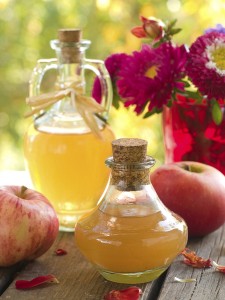Apple Cider Vinegar: Nature’s Magic Potion

When I attended the Natural Products Expo in Anaheim, CA back in March, I came across a number of exhibitors sampling beverages containing apple cider vinegar. Organic apple cider vinegar is recognized as a healthful ingredient, and it’s amazingly versatile in cooking and as a natural health and beauty aid. I always have a bottle on hand.
Most vinegar starts out as fermented grapes, but it can be made from any number of fruits, even honey. It’s good for you because it is infused with minerals, vitamins and amino acids, plus it helps fight bacteria and aids digestions as well as other healthful properties. The most beneficial vinegar is made from apples.
 Hippocrates, the father of modern medicine used vinegar as an antiseptic. Unpasteurized vinegar may contain up to 50 different nutrients, including those from its source, like apples. It’s important to use unpasteurized, un-distilled apple cider vinegar because it still contains the ‘mother’ that is created when acetic acid bacteria and a type of cellulose develop during the fermentation process. It makes the vinegar look cloudy and unappetizing, but believe me, that’s where the good stuff is. Pasteurizing vinegar kills the microorganisms, but it also kills enzymes and heat-sensitive vitamins. White, distilled vinegar has had the natural, toxin-fighting malic and tartaric acids destroyed. Without these you lose much of vinegar’s ability to inhibit harmful bacteria.
Hippocrates, the father of modern medicine used vinegar as an antiseptic. Unpasteurized vinegar may contain up to 50 different nutrients, including those from its source, like apples. It’s important to use unpasteurized, un-distilled apple cider vinegar because it still contains the ‘mother’ that is created when acetic acid bacteria and a type of cellulose develop during the fermentation process. It makes the vinegar look cloudy and unappetizing, but believe me, that’s where the good stuff is. Pasteurizing vinegar kills the microorganisms, but it also kills enzymes and heat-sensitive vitamins. White, distilled vinegar has had the natural, toxin-fighting malic and tartaric acids destroyed. Without these you lose much of vinegar’s ability to inhibit harmful bacteria.
Unpasteurized apple cider vinegar (ACV) contains potassium, phosphorous, trace minerals, pectin and enzymes. It may increase insulin sensitivity, which is good for fighting Type 2 diabetes and managing blood sugar.
Here are 11 more reasons to make a place in your pantry for apple cider vinegar:
- It’s low in calories – Apple cider vinegar (ACV) has only three calories per tablespoon. It’s delicious in any recipe calling for vinegar. Added to a little organic olive oil, dried herbs and mustard makes a tangy lower calorie salad dressing.
- It inhibits the growth of bacteria — Vinegar has been used as a food preservative for thousands of years. The main substance in vinegar, acetic acid, can kill harmful bacteria such as E. coli and/or prevent them from reaching harmful levels.
- The acetic acid in vinegar can help weight loss—Some find it suppresses appetite. Scientists also theorize that vinegar may help inhibit the body’s absorption of starch.
- It soothes a sore throat — Gargle with apple cider vinegar mixed with warm water to relieve a sore throat and help kill the bacteria causing it. Also helps eliminate bad breath.
- It can clear a stuffy nose — The potassium in vinegar can help clear a stuffy nose and prevents bacteria growth. Put a teaspoon in a glass of water and drink.
- It reduces ‘bad’ cholesterol – There is some evidence that acetic acid in vinegar can help reduce LDL cholesterol associated with heart disease.
- It calms the stomach — The pectin in apple cider vinegar can help soothe an upset stomach.
- It can boost energy –– Amino acids, enzymes and potassium may boost your energy level. Try a tablespoonful of ACV when you find yourself dragging in the afternoon.
- It makes your hair shiny — Use as a rinse to remove built-up products in your hair. Dilute vinegar and use once a week. Good for dandruff and dry, itchy scalp, too.
- It give you glowing skin – Good as toner for skin because of its bacteria-fighting properties. Plus, it balances PH of your skin and may help fight blemishes.
- It relieves aching muscles – Put a cup of ACV in a warm tub.
Try my delicious, anti-aging recipe for Chicken Adobo that includes apple cider vinegar. This Philippine adobo is inspired by the original Spanish version. In the Philippines an adobo is meat cooked in a mixture of soy sauce, vinegar, and garlic. I like to top this chicken adobo with onion rings that I’ve dehydrated and dried garlic slices.
Chicken Adobo
Serves 4
Ingredients
1 whole organic or free-range chicken, cut into 8 serving pieces
1 cup apple cider vinegar
¾ cup olive oil, divided in half
¼ cup low-sodium soy or tamari sauce
2 Tbsp. minced garlic
1 Tbsp. sea salt
1/2 tsp. black pepper
For Garnish
½ cup onions, sliced
¼ cup garlic, sliced
Procedure
1. Place the chicken parts in a large, enamel-covered cast-iron pan with a fitted lid. Add the remaining ingredients except for ¼ cup of the oil.
2. Bring the sauce and the chicken to a boil over high heat. Leave the pan uncovered.
3. Reduce the heat to low and simmer for 30 minutes or until the poultry is cooked through.
4. Once the poultry is cooked, remove the cover from the pan and simmer another 10–15 minutes or until the sauce is thick.
5. Remove from the heat and stir in the remaining oil.
6. Roast the garlic and onions in a 300 degree oven for 20 minutes. Garnish the chicken with the garlic and onions.

